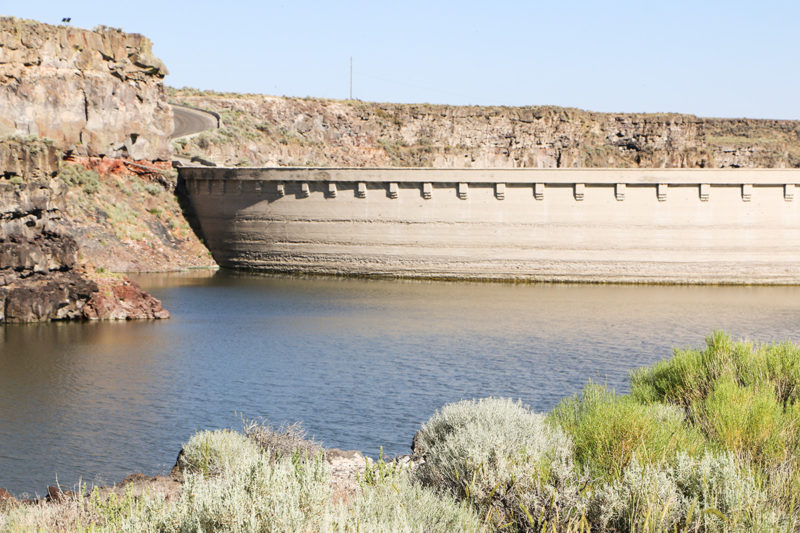I am jealous of kids that are afraid of the dark. I get it, the dark is full of the unknown, but the dark is pretty tame compared to my childhood fears. I was 5 years old when Mount St. Helens erupted. I grew up at the base of the Jarbidge Mountains, and everyone knows about the crater in the peak nearest Idaho. In my childhood, every time the clouds around the mountain would billow, I thought the mountains were erupting. How does a child escape the cataclysm of hot liquid magma? Especially when his parents seem indifferent to the threat?
Just recently, a geologist explained that the crater in the Jarbidge Mountains was not volcanic but was instead glacial. The volcanic activity in our area was a super volcano whose crater is in the middle of the desert to the north of me. I should have spent my youth fearing north instead of south.
Similarly, as a child, I was terrified of Salmon Dam. We would cross Salmon Dam going and coming whenever we drove to town. The approach was a single-lane dirt road with no barrier between the road and the abyss 250 feet below. My fear should have been the road, but my real angst was the dam washing out.
I was 6 months old when the Teton Dam disaster occurred. Eleven people were killed along with 16,000 head of livestock, and there was approximately $400 million in downstream damage. It was still fresh enough in the public consciousness that I was aware of it. This led to my fear of Salmon Dam crumbling beneath our vehicle.
I have since discovered that the dam is composed of 300,000 tons of solid concrete, and engineers would breach the basalt surrounding the dam instead of the concrete itself. Salmon Dam isn’t going anywhere. However, in making the case for the immovability of dams, there is a new, more dangerous threat to dams … politicians.
In the January issue of Ag Proud – Idaho, there was an article on the impacts of dam breaching on the Snake River, all in the name of restoring salmon habitat. I encourage you to re-read the article, but one thing stands out to me. The cost to replace the energy produced from the four dams on the lower Snake River would be $12 billion, if we use technology not yet developed. If we use current technology, it will cost $77 billion. That is a pretty bold spread, even for government accountants.
Imagine a world where regular folks use this type of economic forecasting. Imagine getting a quote from your custom harvester: “It will cost 12,000 dollars with technology not yet commercially viable or 77,000 dollars using today’s technology.” Or how about buying a pivot? “It will cost 120,000 dollars with technology not yet developed or 770,000 dollars with technology from here and now.” Take a quote like this to your bank and see what they say. After the laughter subsides, they will suggest you find alternative financing.
The government is a different story. The meat grinder that is government makes sausage differently than the private sector, so nobody laughs when politicians use these astronomical numbers.
In a March 21, 2023, speech, President Joe Biden referenced a plan to remove four dams on the lower Snake River to “bring healthy and abundant salmon runs back to the Colorado [Columbia] River system” (as quoted from the White House website). As convoluted as this quote is, this announcement is the most coherent part of their plan.
When it comes to dam breaching, the rest of the Pacific Northwest is concerned with the loss of 3,000 megawatts of hourly capacity. That is enough electricity to power 800,000 homes. But we in agriculture are more concerned with the loss of irrigation capacity and the loss of a key transportation route for 80 to 100 million bushels of Palouse grain annually.
The dam breaching seems to be a solution desperately searching for a problem. Over the past 20 years, the federal government has spent $17 billion on hatcheries and fish ladders to improve salmon runs. Even this price tag seems exorbitant, but at least it is working. Salmon runs have rebounded, which should be the measure of success. However, environmentalists have a different goal for success, and one of those goals is dam breaching, regardless of whether it improves salmon habitat or not. It’s not about the salmon at all.
In our drive to return ecosystems to their natural state, I have one reminder for our society: Nature can be very ugly. The natural world will spread its ugliness with the indifferent glee of a Yellowstone bison tossing an international tourist across a field. That is the thrill of nature; it is a chance to hone our prehistoric instincts from a time when everything around us would bite, sting, fight, poison or devour us.
Yes, nature is ugly, and that was why our forefathers worked so hard to tame nature. They eliminated threats we encounter daily. They also tamed climatological threats like flooding, drought and famine, but it required dams on rivers. We should be reluctant to remove these modern marvels. We should craft public policy that appreciates the society-enhancing advancements of the last 150 years. We can listen to the ideas of environmentalists, but don’t implement their ridiculous public policy.
It turns out my biggest fear as an adult are environmentalists – and the politicians that empower them.


.jpg?t=1687979285&width=640)


